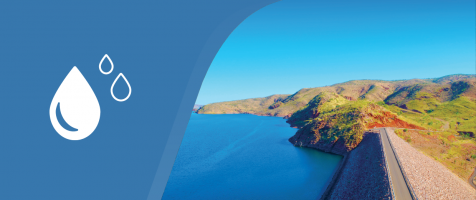Where there was once an annual average of 420 GL of water running into Perth dams, planning is now based on just 25 GL per year. Since 1980, water tables across the Gnangara Mound have fallen by up to 10 metres – a 1,000 GL loss of aquifer storage.
Strategic justification
Water is one of society’s most vital commodities and the state’s future economic and population growth is highly reliant on the availability and security of suitable water at an economically viable price. Major impacts of climate change on the state’s traditional water sources will require increasingly innovative solutions to ensure adequacy of long‑term water supply and to enable the state to sustain its economy, environment and way of life for years to come.
Sector challenges and opportunities
Along with population growth, economic growth and land development, climate change is now a critical consideration for water planning. The state’s increasingly drying climate is driving the need to invest in alternative, climate-independent water sources, principally desalination (from seawater and other brackish sources) and recycling of wastewater. An understanding of the cultural and spiritual value of water to Aboriginal people is also important when planning for the management of the state’s water resources.
The Integrated Water Supply Scheme (IWSS) is a critical, centralised infrastructure network providing water to more than 2 million people in Perth, the Goldfields and surrounding agricultural regions and parts of the South West and Great Southern regions. Two seawater desalination plants produce approximately 47% of the IWSS water supply, and an innovative groundwater replenishment scheme (where treated wastewater is recharged into groundwater supplies) supplements the IWSS. However, it is predicted that even with successful demand management and maximum production from existing sources, a new water supply source will be required within 10 years.
Major water source augmentations are expensive and energy-intensive. Service providers also need to reduce their carbon emissions and adopt low-carbon practices and technologies as they move towards meeting the WA Government’s net zero emissions by 2050 aspiration.
Self‑supplied use is where water is drawn directly by individuals, local governments and industrial, commercial or agricultural enterprises using infrastructure, such as bores and/or dams. Self-supplied water sources are currently managed, in part, through water-allocation plans. It is important that these plans are updated on a regular basis, especially for strategic water resources. While demand management measures have been successful for scheme water, similar measures have not been broadly implemented for many self-supplied users.
As the impacts of climate change become more pronounced, it will be essential to adopt total water cycle thinking and appropriately use all available water sources, such as stormwater and wastewater, while driving more efficient practices. Ensuring planning and regulatory frameworks enable investment in alternative water sources will be important to optimise fit for purpose water use.
While circular economy concepts such as water recycling, reuse of waste by‑products and conversion of waste to energy are already being adopted to some extent in WA, there is no indication whether there is a long‑term objective to realise the full potential of a circular economy in the water sector. To fully embrace the circular economy concept, a major step change would be required across several sectors and may require changes in legislation.
There is currently no contemporary, long-term, statewide direction for the water sector. It is important for the government, through its primary water policy agency, to provide strategic direction and guidance for water utilities and other water sector participants.
To further enable a progressive, resilient water sector, a modern legislative framework is required. While some reform measures have been progressed, there is further work to be done to develop a framework that is flexible, progressive and capable of managing water today and in the future.
Case study
As part of its Integrated Water Management Strategy, Aqwest is implementing the Bunbury Water Resource Recovery Scheme, with $14.1 million allocated from the state government’s WA Recovery Plan. The scheme will provide 5.6 ML of recycled water per day to irrigate public open spaces in Bunbury and to use on major infrastructure projects such as the Bunbury Outer Ring Road. For further information, refer to: https://aqwest.com.au/community-and-education/local-projects/bunbury-water-resource-recovery-scheme

